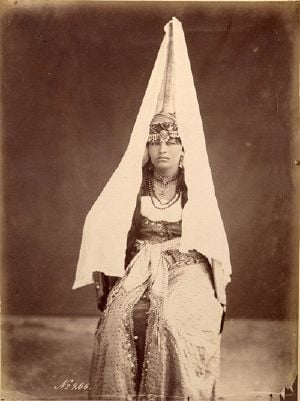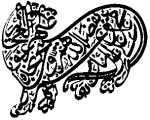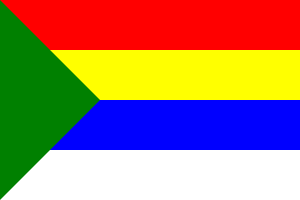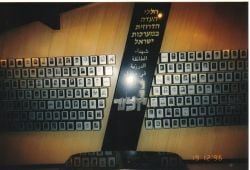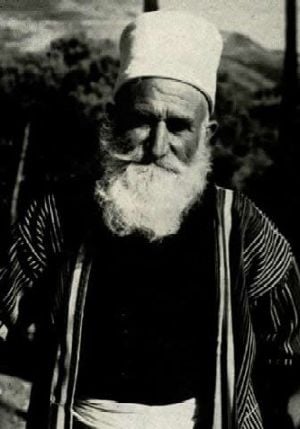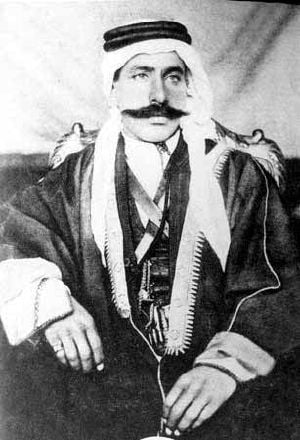Druze
| Druze دروز | ||||||||||||||||||
|---|---|---|---|---|---|---|---|---|---|---|---|---|---|---|---|---|---|---|

|
||||||||||||||||||
| Total population | ||||||||||||||||||
|
800,000 to 2,000,000 | ||||||||||||||||||
| Regions with significant populations | ||||||||||||||||||
| ||||||||||||||||||
| Religions | ||||||||||||||||||
|
Druzism | ||||||||||||||||||
| Scriptures | ||||||||||||||||||
|
Rasa'il al-hikmah (Epistles of Wisdom) | ||||||||||||||||||
| Languages | ||||||||||||||||||
|
Arabic, Hebrew |
The Druze (Arabic: درزي, derzī or durzī, plural دروز, durūz; Hebrew: דרוזים, Druzim; also transliterated Druz or Druse) are a Middle Eastern religious community whose traditional religion is said to have begun as an offshoot of the Ismaili sect of Islam, but is unique in its incorporation of Gnostic, neo-Platonic and other philosophies. Druze consider themselves theologically as "an Islamic Unist, reformatory sect",[5]. The Druze call themselves Ahl al-Tawhid ("People of Monotheism") or al-Muwahhidūn ("Monotheists"). The origin of the name Druze is traced to Nashtakin ad-Darazi, one of the first preachers of the religion.
The Druze religion was first promulgated in 1017, during the reign of the sixth Fātimid caliph al-Hakim bi-Amr Allah, (“Ruler by the Command of Allah”) who ruled over Egypt (r. 996–1021), whom the Druze thought to be an actual incarnation of God. The Druze practice taqiyya and are publicly open about very few details of their faith. Under persecution, a Druze is allowed to deny his faith outwardly if his life is in danger. The Druze permit no conversion, either away from or to their religion, and no intermarriage. Only members of an inner spiritual elite called al-ˤUqqāl (عقال), "the Knowledgeable Initiates" have access to the secret teachings of the hikmah, the Druze religious doctrine. The Druze people have figured prominently at various periods in Middle Eastern history, during the Crusades, under the Ottoman Empire, in Lebanon during the nineteenth century, and in the Israeli military during the twentieth century.
Location
The Druze reside primarily in Syria (country with largest population), Lebanon (country with highest percentage), and Israel, with a smaller community in Jordan.[6] The Israeli Druze live mostly in the Galilee (70 percent) and around Haifa (25 percent), and the Jordanian Druze can be found in Amman and Zarka, and a smaller number in Irbid and Aqaba. The Golan Heights, a region captured by Israel from Syria during the Six-Day War in 1967, is home to about 20,000 Druze,[7] and consists of a Syrian citizen-majority and an Israeli citizen-minority. The Institute of Druze Studies estimates that 40 to 50 percent of Druze live in Syria, 30 to 40 percent in Lebanon, 6 to 7 percent in Israel, and 1 to 2 percent in Jordan.[3]
Large communities of expatriate Druze also live outside the Middle East, in the United States, Canada, Latin America, West Africa, Australia and Europe. They use the Arabic language and follow a social pattern very similar to the East Mediterraneans of the region. Most Druze consider themselves Arabs.
There are thought to be as many as one million Druze worldwide, the vast majority in the Levant or East Mediterranean.[8] However, some estimates of the total Druze population have been as low as 450,000.[9]
Ethnic Origin and Genetics
Traditionally there were two branches of Druze living in the Jabal Amel region, the Yemeni Druze (headed by the Hamdan and Al-Atrash families) and Kaysi Druze (headed by the Jumblat and Arsalan families). The Hamdan family was banished from Mount Lebanon following the battle of Ain Dara in 1711, between the Yemeni and the Kaysi Druze factions. Following their dramatic defeat, the Yemeni faction (headed by the Hamdan and Al-Atrash families) migrated to Syria in the Jebel-Druze region and its capital, Soueida.
DNA testing shows that an unusually high percentage, 35 percent, of Druze males carry the Y-chromosomal haplogroup L, which is otherwise uncommon in the Mideast [10] This haplogroup originates from prehistoric South Asia.
History
|
Part of a series on Shia Islam |
| Branches |
|
Nizari • Druze • Mustaali |
| Pillars |
|
Walayah • Salah |
| Concepts |
|
The Qur'an • The Ginans |
| History |
|
All Imams • Fatimid Empire |
| Early Imams |
|
Ali • Hasan • Husayn |
| Contemporary Leaders |
|
Aga Khan IV |
The Druze religion began to develop during the Middle Ages. In the eleventh century C.E., the Druze religion emerged from the Ismaili sect, a sub group of Shia Islam. It is not known whether the Druze people were a distinct ethnic group before adopting their present religion. The Druze did not attempt to reform mainstream Islam, but to create a whole new religious body combining various Jewish, Christian, and Iranian elements influenced by Greek philosophy and Gnosticism, including a form of reincarnation in which Druze reincarnate as future descendants.
The Druze believe the sixth Fātimid caliph al-Hakim bi-Amr Allah, (“Ruler by the Command of Allah”) who ruled over Egypt (r. 996–1021), to be an actual incarnation of God. The first to hold that view was a man called Hasan ibn Haidara al-Ahram, an Ismaili Da'i and courtier of al-Hakim. It remains unclear whether al-Hakim shared these views, but he at least tolerated Hamza's activities. Hakim disappeared one night in 1021 under mysterious circumstances. According to historical research, he was most probably assassinated on the orders of his older sister. The Druze, however, believe that Hakim went into occultation and will return in the end of days as the Qā'im "Ariser" or Mahdi "Guider" to inaugurate a golden age.
After the assassination of al-Hakim, his cause was taken up by the Persian immigrant Hamza ibn ˤAlī ibn Aḥmad, who in a letter dated 1017 had demanded that all officers and courtiers should acknowledge divinity of al-Hakim, and the previous Fatimid Caliphs and Ismaili Imams. Hamza became the actual architect of the Druze religion. The group derives its name from Hamzah's subordinate, Muhammad ad-Darazi.
After Hakim's disappearance, the Druze were forced to adopt taqiyya, the practice of concealing their true beliefs, common among Ismailis. They outwardly accepted the religious beliefs of those among whom they lived, while secretly retaining their true convictions. A noted traveler Benjamin of Tudela wrote about the Druze in his diary in 1167, describing them as "Mountain dwellers, monotheists, [who] believe in soul transfigurations and are good friends with the Jews."
The Druze have played an important role in the history of the Levant. They were mostly scattered in the Chouf Mountains, which are part of Mount Lebanon (known for some time as the Mount of the Druzes), and later the eponymous Jabal al-Durūz (Mount of the Druzes) in Syria, which was an autonomous state in the French Mandate of Syria from 1921 to 1936, under the same name.
The Druze people figured prominently in the Arab stand against the Crusades. In the century following the Ottoman conquest (from 1516), they prospered as powerful vassals of the Ottoman Empire, until their Lebanese leader Fakhr ad-Din of the house of Ma'n was driven out and took asylum at the courts of Tuscany and Naples. In the nineteenth century, Druze dominated the Lebanese aristocracy under the ruling Shihab family (who were Sunni Muslims).
The Druze also played a major role in the Lebanese Civil War (1975–1990). They organized a militia under the leadership of Walid Jumblatt (son of Kamal Jumblatt), in opposition to the Maronite Christian Phalangist militia of Bachir Gemayel in the Mount Lebanon area (especially the Chouf). A peace treaty was then signed between the Druze and Maronite leaders which has enabled them to live peacefully together and later become allies.
The Druze Today
In Lebanon, Syria and Israel, the Druze have official recognition as a separate religious community with its own religious court system. Their symbol is an array of five colors: green, red, yellow, blue and white. Each color pertains to a symbol defining its principles: green for ˤAql "the Universal Mind," red for 'Nafs' "the Universal Soul," yellow for Kalima "the Truth/Word," blue for Sabq "the Antagonist/Cause" and white for Talī "the Protagonist/Effect." The number five, representing these principles, has special significance in the Druze community, and is usually represented symbolically as a five-pointed star.
In Israel
In Israel, where the Druze enjoy prominence in the military and in politics far out of proportion to their population numbers, the majority of Druze do not identify themselves as Arabs [11]. Since 1957 the Israeli government has officially recognized the Druze as a distinct ethnic community, at the request of the community's leaders.
Israeli Druze serve in the Israeli army, voluntarily during 1948-1956, and, at the community's request, compulsorily ever since.[12] Their privileges and responsibilities are the same as those of Israeli Jews; thus, all Druze are subject to the draft, but exemptions are given for religious students and for various other reasons. Israeli Druze have achieved high positions of command in the Israeli military. Most recently in the 2006 Lebanon War, the all-Druze Herev [sword] Battalion, through their knowledge of the Lebanese terrain, suffered no casualties and are reported to have killed twenty Hezbollah fighters, triggering suggestions that the battalion be transformed into a sayeret (elite unit).
In January 2004, the spiritual leader of the Druze community in Israel, Shaykh Mowafak Tarif, signed a declaration calling on all non-Jews in Israel to observe the Seven Noahide Laws as laid down in the Bible and expounded upon in Jewish tradition. The mayor of the Galilean city of Shfaram also signed the document.[13] The declaration includes the commitment to make a "… better humane world based on the Seven Noahide Commandments and the values they represent commanded by the Creator to all mankind through Moses on Mount Sinai."[13]
Support for the spread of the Seven Noahide Commandments by the Druze leaders reflects the biblical narrative itself. The Druze community reveres the non-Jewish father-in-law of Moses, Jethro, whom Muslims call Shuˤayb. According to the biblical narrative, Jethro joined and assisted the Jewish people in the desert during the Exodus, accepted monotheism, but ultimately rejoined his own people. In fact, the tomb of Jethro near Tiberias is the most important religious site for the Druze community.[14] It has been claimed that the Druze are actually descendents of Jethro.
The relationship between Israeli Jews and Druze since Israel's independence in 1948 is both emotional and practical, partly because of the considerable number of Israeli Druze soldiers that have fallen in Israel's wars, and is referred to as brit damim, "covenant of blood." This expression has however been criticized in recent years as representing a limited relationship which does not provide enough opportunity for Israeli Druze youth beyond traditional military careers.[15]
Some of Druze living in the Golan Heights, which came under Israeli rule in 1967 and Israeli law, jurisdiction and administration in 1981, consider themselves Syrian and refuse Israeli citizenship.
Beliefs of the Druze
The Druze faith keeps its tenets secret. Druze practice taqiyya, tagiya) and are publicly open about very few details of their faith. Under persecution, a Druze is allowed to deny his faith outwardly if his life is in danger. This concession is specifically allowed according to at-Ta'lim (“Instruction”), the anonymously written “catechism” of Druze faith. For various religious, political and historical reasons, the Druze do not accept converts and strongly discourage conversion from their religion to another. The Druze do not fear that their religion will disappear, however, since they believe that the number of Druze adherents in the world has remained constant since its inception.
The Druze believe in the unity of God, hence their preference for the name "People of Monotheism" or "Monotheists." Their theology has a Neo-Platonic view of God’s interaction with the world through emanations, and is similar to some gnostic and other esoteric sects. They are not, however, influenced by the Sufi philosophy, as many believe. The Druze believe in reincarnation and are not pantheistic. They believe in one God and seven prophets - Adam, Noah, Abraham, Moses, Jesus and Muhammad. They revere Jethro and make an annual pilgrimage to his tomb at the Horns of Hittin.
The principles of the Druze faith are: guarding one's tongue (honesty), protecting one's brother, respecting the elderly, helping others, protecting one's homeland, and belief in one God. Another well-known feature of the Druze religion is a fervent belief in reincarnation, only as humans, for all the members of the community. They reject polygamy, slavery, tobacco smoking, alcohol, and consumption of pork.
Druze religion does not allow them to intermarry with Christians, Muslims, Jews, or members of any other religions.
It is also known that Druze believe in five cosmic principles, represented by the five colored Druze star: intelligence/reason (green), soul (red), word (yellow), precedent (blue), and immanence (white). These virtues take the shape of five different spirits which, until recently, have been continuously reincarnated on Earth as prophets and philosophers including Adam, the ancient Greek mathematician and astronomer Pythagoras, and the ancient Pharaoh of Egypt Akhenaten, and many others. The Druze believe that, in every time period, these five principles were personified in five different people who came down together to Earth to teach humans the true path to God and nirvana, but that with them came five other individuals who would lead people away from the right path into "darkness."
The Druze believe in prophets like Adam, Muhammed (mohamad), Noah (Nūħ), Abraham (Ibrāhīm), Sarah, Jacob (Yaˤqub), Moses (Mūsā), Solomon (Sulaymān), John the Baptist (Yahya), and Jesus (Isā) and Jethro, or (Shuayb). They also believe in the wisdom of classical Greek philosophers such as Plato and Pythagoras, who have the same stature as other prophets. In addition, they have an array of "wise men" that founded the religion in the eleventh century.
Individual prayer does not exist. Druze are not required to follow the Muslim duties of prayer, fasting, or pilgrimage to Mecca. One of the faith's holy books is called the Kitābu l-Hikma or "Book of Wisdom," largely compiled by a mysterious figure called al-Muqtana. It has six volumes and is compiled in chapters, each covering a specific issue. The teachings denounce materialism, especially materialism relative to religion. As the religion is surrounded in secrecy (Arabic: باطنية i.e., internal 'not to be declared') a strict system is followed to hide the articles and sacred books of Druze.[16]. The sacred books of the Druze, successfully hidden from the world for eight centuries, have since the middle of the nineteenth century found their way into European libraries.[17]
ˤUqqāl and Juhhāl
The Druze are split into two groups. Members of the outer group, called al-Juhhāl (جهال), "the Ignorant," who are not granted access to the secret Druze holy literature, form the Druze political and military leadership and generally distance themselves from religious issues. They comprise perhaps 90 percent of the Druze.
Members of the inner group are called al-ˤUqqāl (عقال), "the Knowledgeable Initiates." Women are considered especially suitable to become ˤUqqāl; they are regarded to be spiritually superior to men. Druze women who are ˤuqqāl can opt to wear al-mandīl, a transparent loose white veil, especially in the presence of religious figures. They wear al-mandīl on their head to cover their hair and wrap it around their mouth and sometimes over their nose as well. They wear black shirts and long skirts covering their legs to their ankles. Male ˤuqqāl grow mustaches, shave their heads, and wear dark clothing with white turbans.
The ˤuqqāl themselves are also divided into two groups; about ten percent are al-Ajawīd, a term that means "The Good Ones (diminutive)." They are the leaders of the spiritual life of the Druze.
Druze places of worship are usually very modest and the Ajawīd lead very modest lifestyles. Prayer is conducted discreetly, among family and friends. There is little official hierarchy in the religious community except for the Shaykh al-ˤAql, whose role is more political and social than religious. A religious figure is admired for his wisdom and lifestyle.
Contradictory literature surrounds the Druze mainly due to adopted beliefs that were used to protect them from persecutors and due to the rumors and stories of outsiders. For example, it is still unclear to most outsiders whether the Druze follow the same traditions of fasting as Muslims in the month of Ramadan. Some orthodox Druze hold that they should not follow these traditions, but should follow a different fasting tradition still practiced by religious figures instead. The Druze have other fasting traditions, such as fasting during the ten days before Eid ul-Adha, the last night of which is spent in prayer. The Druze fast is more difficult than the traditional Ramadan fast in that only one light meal is allowed in the evening.
Prominent Druze Figures
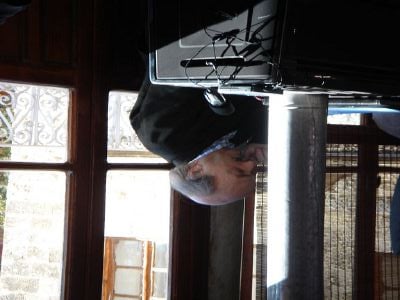
- Fakhreddin II (1588–1635), descendant of the Ma'an Dynasty, ruled at its height what is now Lebanon, part of Syria, Israel and even part of Turkey.
- L'Emir Magid Arslan was the leader of the independence of Lebanon in 1943 when the president Bechara el Khoury with fellow ministers were taken to prison to rachaya by the French. His sons L'Emir Faysal Arslan and L'Emir Talal Arslan fought each other democratically to gain seat in the Lebanese Parliament but L'Emir Talal Arslan won the seat because of Syria's influence over Lebanon during the Lebanese elections in 1992.
- Kamal Jumblatt founded the Lebanese Progressive Socialist Party in the mid-twentieth century and was a major thinker and philosopher; his son Walid Jumblatt remains prominent in Lebanese politics.
- In Israel, Salah Tarif, a former captain in the paratrooper and the tank divisions of the Israeli Army, has been a Knesset member since 1992. He has served as the Deputy Speaker and the Deputy Minister of Internal Affairs and was appointed Minister Without Portfolio in the Sharon government of 2001.
- Colonel Imad Fares, acclaimed commander of the Givati Brigade of the Israeli Army from 2001–2003.
- Major General Hussain Fares, commander of the Israel Border Police.
- Lieutenant General Salim Slim, commander of the Lebanese Judiciary Police.
- Azzam Azzam was accused of spying for Israel by Egypt and jailed there for eight years before being released in late 2004.
- The famous musician Farid al-Atrash, born in Syria's Jabal al-Durūz to Prince Fahed al Atrash (brother of Sultan Pasha al-Atrash). He moved to Egypt with his mother, brother and sister Asmahan (born Amal), who was also a famous singer. He composed hundreds of songs and acted in many movies. Al-Atrache revived the Eastern musical traditions with such pieces as "Lahn al-Khulud," and the Rabeeh Opera.
- Radio announcer Casey Kasem, born Kamal Amin Kasem to Lebanese Druze immigrants to the United States, is probably that country's best-known figure of Druze heritage. About 50,000 Druze live in the United States.
- Sultan Pasha al-Atrash was leader of the revolution against the French occupation of Lebanon and Syria in the 1920s. He is viewed by many Druze, as well as many non-Druze Arabs, as a symbol of courage and defiance to outside influence and occupation.
- Mohammed Nafah, Secretary General of the Israeli Communist Party Maki.
- Majalli Wahabi, Deputy Speaker of the Knesset, appointed as acting President of Israel in February of 2007.
- Ramy Ayach, a famous Lebanese singer.
See also
- List of Druze
- Jabal el Druze (state)
- Alawites
Notes
- ↑ Druze in Syria - Joshua Project. Retrieved July 25, 2016.
- ↑ CRS Issue Brief for Congress - Alfred B. Prados. Foreign Affairs, Defense, and Trade Division Retrieved July 25, 2016.
- ↑ 3.0 3.1 Nissim Dana, The Druze in the Middle East: Their Faith, Leadership, Identity and Status. Retrieved October 17, 2007.
- ↑ International Religious Freedom Report 2005 - US Department of State Retrieved October 17, 2007.
- ↑ Najib Israwi, Al-Maðhab at-Tawḥīdī ad-Durzī, 66 by cited in Samy Swayd, The Druzes: An Annotated Bibliography. (Los Angeles, CA: ISES Publications, 1998. ISBN 0966293207)
- ↑ Druze - Encyclopaedia of the Orient.
- ↑ Localities and Population, by District, Sub-District, Religion and Population Group Israel Central Bureau of Statistics Retrieved October 17, 2007.
- ↑ Druze set to visit Syria - BBC News Online. Retrieved October 17, 2007.
- ↑ Major Branches of Religions Ranked by Number of Adherents - Adherents.com. Last updated 28 October 2005. Retrieved October 17, 2007.
- ↑ Shen et al. 2004 "Reconstruction of Patrilineages and Matrilineages of Samaritans and Other Israeli Populations From Y-Chromosome and Mitochondrial DNA Sequence." VariationResearch Article - evolutsioon.ut.ee. Retrieved October 17, 2007.
- ↑ Izhak Schnell and Muhammad Amara. "Identity Repertoires among Arabs in Israel." Journal of Ethnic and Migration Studies 30 (2004). ISSN 1369-183X
- ↑ Gabriel Ben-Dor.The Druze Minority in Israel in the Mid-1990s. Jerusalem Letters of Lasting Interest 315 (3 Sivan 5755), (1 June 1995) JCPA. Retrieved October 17, 2007.
- ↑ 13.0 13.1 Islam Religious Leader Commits to Noahide "Seven Laws of Noah".Institute of Noahide Code. Retrieved October 17, 2007.
- ↑ Druze Religious Leader Commits to Noachide "Seven Laws" - Arutz Shera. Retrieved October 17, 2007.
- ↑ Kais M. Firro. The Druzes in the Jewish State: A Brief History. Retrieved October 17, 2007.
- ↑ Mawsu'at al-Adian wal-Mathaheb al-Mu'asserah (Arabic for: Contemporary Religions and Sects Encyclopedia), Published by Rabitat al-'Aalam al-Islami.
- ↑ John Arendzen, Druzes - The Catholic Encyclopedia, 1905 ed., Retrieved October 17, 2007.
ReferencesISBN links support NWE through referral fees
- Abu-Husayn, Abdul-Rahim. The view from Istanbul Lebanon and the Druze Emirate in the Ottoman chancery documents, 1546-1711. London: Centre for Lebanese Studies in association with I.B. Tauris Publishers, 2004.
- Alameddine, Rabih. I, the Divine: A Novel in First Chapters. New York: Norton, 2001. ISBN 039304209X
- Betts, Robert Brenton. The Druze. New Haven: Yale University Press, 1988. ISBN 0300041004
- Dana, Nissim. The Druze in the Middle East: Their Faith, Leadership, Identity and Status. Sussex Academic Press, 2003.
- Destani, Bejtullah (ed.) Minorities in the Middle East: Druze Communities 1840-1974. Slough: Archive Editions, 2006. ISBN 1840971657
- Firro, Kais M. The Druzes in the Jewish State: A Brief History. (Social, Economic and Political Studies of the Middle East and Asia) (Social, Economic and Political Studies of the Middle East and Asia) Leiden: Brill Academic Publishing, 1999. ISBN 9004112510
- Israwi, Najib. "Al-Maðhab at-Tawḥīdī ad-Durzī," 66 by cited in Samy Swayd, The Druzes: An Annotated Bibliography. Los Angeles, CA: ISES Publications, 1998. ISBN 0966293207
- Makārim, Sāmī Nasīb. The Druze faith. Delmar, NY: Caravan Books, 1974. ISBN 0882060031
- Obeid, Anis I. The Druze & their faith in Tawhid. Contemporary issues in the Middle East. Syracuse: Syracuse University Press, 2006. ISBN 0815630972
- Swayd, Samy S. Historical Dictionary of the Druzes. Lanham, MM: Scarecrow Press, 2006. ISBN 0810853329
External links
All links retrieved January 30, 2024.
- Shishakli and the Druzes: Integration and Intransigense by Joshua Landis
- Druze by Pam Rohland
- American Druze Society - druze.com
- Canadian Druze Society - druze.net
- European Druze Society - europeandruzesociety.com
- Druze: A small peace of Israel by Kevin Widdop. HackWriters.com
Credits
New World Encyclopedia writers and editors rewrote and completed the Wikipedia article in accordance with New World Encyclopedia standards. This article abides by terms of the Creative Commons CC-by-sa 3.0 License (CC-by-sa), which may be used and disseminated with proper attribution. Credit is due under the terms of this license that can reference both the New World Encyclopedia contributors and the selfless volunteer contributors of the Wikimedia Foundation. To cite this article click here for a list of acceptable citing formats.The history of earlier contributions by wikipedians is accessible to researchers here:
The history of this article since it was imported to New World Encyclopedia:
Note: Some restrictions may apply to use of individual images which are separately licensed.
